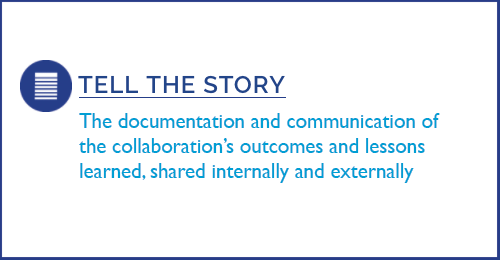Aug 24 2017 Diving Into The Intersector Toolkit: Tell the Story
 We recently updated our Toolkit for Intersector Collaboration to provide even more useful advice to practitioners involved in cross-sector collaborations. We’re profiling each of our 17 tools on our blog, with a focus on resources that can help collaborations succeed.
We recently updated our Toolkit for Intersector Collaboration to provide even more useful advice to practitioners involved in cross-sector collaborations. We’re profiling each of our 17 tools on our blog, with a focus on resources that can help collaborations succeed.
Whether a cross-sector collaboration has reached an important milestone or is wrapping up a long-term project, telling the story is a key step in collaborative work. Documenting and communicating a collaboration’s outcomes and lessons learned, both internally among partners and externally, creates transparency, enables partners to communicate the value of cross-sector collaboration, and allows others to learn from, and potentially replicate, a collaborative approach. Given the increasing interest in cross-sector collaboration, it is important for the collaboration to decide how it will tell its story in a way that will be understood by both internal and external stakeholders — whether communicating about the collaboration’s process or its outcomes.
For assistance in communicating about their work, practitioners can see The Partnering Initiative’s “Talking the Walk,” which offers many helpful one-page tools.
- Tool 1: Preparation Activities, Communication Planning (p. 72) highlights key areas to consider in communications planning. The Partnering Initiative suggests that preparation for a communication plan should start as soon as partners have agreed on goals or objectives for the partnership and are close to signing a partnering agreement.
- Tool 2: Content and Coverage (p. 73) provides a detailed worksheet for drafting a communications plan, including components like communications objectives, key messages, and more.
- Tool 5: Key Questions and Considerations (p. 76) provides guidance for preparing to communicate externally, with a focus on aligning around key issues like timing, audience, and partners’ needs and expectations.
- Tool 7: Document Checklist (p. 78) is a checklist that walks partners through issues like word choice, organization, and design in communications documents. The Partnering Initiative notes that this tool applies to most forms of writing, whatever the avenue or medium.
- Tool 8: Options and Considerations (p. 79) details different methods/formats for communicating, including community meetings, advertising, media releases, and more.
- Tool 9: Communication Assessment Tool (p. 80) provides guidance on monitoring and assessing your communications.
Also see Communicating Beyond the Partnership (found on pp. 27-35) for helpful context for these tools.
For detailed guidance on communicating an evaluation of cross-sector work to internal and external constituencies see Interpreting and Using Evaluating Information in The University of Wisconsin Cooperative Extension’s “Evaluating Collaboratives: Reaching the Potential” (found on pp. 45-52). This resource highlights the importance of communicating the outcome of collaboration and walks practitioners through various potential audiences (e.g., interest groups, funders, the community at large) and ways to present results.
Lastly, collaborations seeking to tell their story via a case study can see The Partnering Initiative’s “The Case Study Toolbook.” This resource provides comprehensive, actionable guidance complete with detailed, broadly adaptable tools and can be used by individuals internal and external to the collaboration in commissioning, researching, writing or disseminating partnership case studies. It covers the writing process, making sense of data, using case studies as tools for change, and more.
See Tell the Story in our Toolkit for further discussion on this topic, questions to guide tool use, and more.
Explore the full Toolkit and each of the 17 tools with enhanced discussion, questions to guide tool use, and additional resources here.
